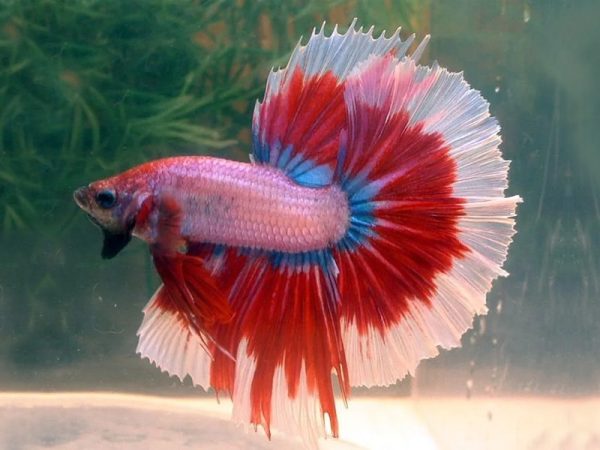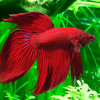Address
Center: Georgiou Theochari 4 Thessaloniki 54621
Kalamaria: Georgiou Papandreou 17A Thessaloniki 54645
Opening hours
Monday - Friday: 9am - 7pm
Saturday: 9am - 2:30pm
Address
Center: Georgiou Theochari 4 Thessaloniki 54621
Kalamaria: Georgiou Papandreou 17A Thessaloniki 54645
Opening hours
Monday - Friday: 9am - 7pm
Saturday: 9am - 2:30pm








Scientific Name: Betta splendens.
Other Names: Siamese fighting fish
Greek Name: Monomachos.
Water Category: Freshwater.
Genaral category: Labyrinth fish or Anabantids (Anabantidae).
Family: Anabantoidei.
Subfamily: Belontiidae.
Origin: It originates from Asia, particularly central and western Thailand.
Habitat it lives in: It lives in rice paddies (rice fields) and in canals.
Final size: 5 to 7 centimeters (excluding the caudal fin), with males being slightly larger than females.
Age: It lives in the aquarium for an average of 2 years, although longer lifespans have been reported. Its lifespan depends to a large extent on its pre-acquisition environment and the first few weeks of its life.
Water Conditions:
PH: 6-7.5
GH: 4-12°dGH
Temperature: 22-28°C
Recommended Tank Size: More than 20 in a well-planted aquarium for a relatively decent cohabitation, personally, I recommend a 50-liter aquarium.
Gender separation: The main difference in appearance is that males have significantly larger fins compared to females and more vibrant colors.
Body Shape: Males typically have a thinner or 'plakat' body shape, as opposed to females which have a rounder and thicker body, especially in the area immediately behind the 'belly.' In this area, between the 'belly' and anal fin, the ovaries are located in females. In some lighter colorations, they can appear as elongated, translucent structures that start from the lateral fins and extend towards the posterior part of the body. Additionally, females generally have wider fins compared to males. Especially in the case of plakat females, the fins are very close together and have a distinct shape. In male plakats, the pelvic fins are relatively farther apart, while in females, they are relatively close together. Furthermore, the dorsal fin in males is larger than in females and forms a pointed tip towards the posterior. In females, it is usually narrower, more uniform, and, starting from the base, runs almost parallel to the body until the caudal fin.
Social Behavior: It is a solitary species with personality. It is a very intelligent fish, and many claim that it recognizes its caretaker. However, it is also one of the most neglected fish species because their ability to breathe atmospheric air and their peculiar nature of not coexisting with other fish of the same species or with fish with large fins have led traders to keep them in small containers, usually cups, resulting in one of the worst living conditions.
The fact that, indeed, if two males are placed together, they will fight. This is because in nature, each fish usually maintains a small territory (which changes from time to time) where it builds a nest and waits for a female to pass by for mating. If another male comes along, it will defend this territory by any means. In nature, they rarely fight to the death; usually, the losing fish retreats. However, in a confined space like a glass aquarium, they are forced to stay and fight to the death. The fact that these fighters are often kept in small containers that they consider their territory further escalates this aggression, whether it's towards a female when they are not ready to mate or towards another species that the fighter considers a threat.
The betta fish, far from being a wild and aggressive species, can be described quite the opposite. It is a small fish (5-7 cm) with a rather slow and peaceful body type, especially compared to other fish of similar size in more "open" waters. It is more at risk from others than it is a threat, even to species of the same size.
The reason it has earned its name is that if placed with another male in an aquarium, unless the aquarium is huge with plenty of hiding spots, they will chase and fight each other until one is defeated, which often results in death due to the confined space of the aquarium where the loser cannot escape. Additionally, it can become aggressive towards a female in an aquarium, especially if the female is not ready to mate or after mating to protect the eggs. In essence, it is what we call an overprotective father, even more so than the mother.
Many hobbyists keep bettas in small tanks ranging from 10 to 30 liters. The betta considers this space to be its territory, and when another species, whether it's fish, shrimp, or even snails like apple snails, enters this territory, it will persistently harass or stress the other species until it dies.
In a tank larger than 100 liters with plenty of plants, driftwood, and slow water flow, a betta can comfortably coexist with small, peaceful fish. You should avoid aggressive fish or fish that may nip at their long fins, such as large barbs or large danios. There are many species that can live together with bettas without bothering each other, such as gouramis under suitable conditions with ample water surface area and additional plants for cover, or botias, small rasboras, and possibly small barbs or zebra danios.
If we are targeting species from other regions we can put in small Tetra and Corydoras, or zoetocas except for the male Guppies whose large tails can fool the gladiator by reminding him of the tails of his own small species and many other small quiet species that have the same water and environmental parameters requirements.
Swimming Zone: Its primary swimming zone is near the surface because it breathes atmospheric air, but it also explores and monitors the entire aquarium.
Diet: It is a carnivorous fish, mainly feeding on insects and mosquito larvae in the wild, so it requires a diet with a higher protein content.
In the market, there are specialized foods available for betta fish, including live, freeze-dried, and frozen options.
It's a good idea to occasionally feed betta fish with boiled pea to help with digestion, as they are considered prone to constipation.
Additionally, it's good for their overall health to regularly provide them with vitamin-enriched food.
If the foods are fresh, it's good to provide them with vitamin-enriched food approximately every 15 days.
Reproduction: It reproduces throughout the year as long as we have prepared the pair and the breeding aquarium appropriately.
The male creates bubbles on the water's surface, and the female, after showing signs that she is ready for breeding (usually marked by vertical stripes on her body), they mate under the bubble nest. The male embraces the female, fertilizing the eggs that start falling from her body. He collects the eggs in his mouth and places them in the bubble nest.
This process usually lasts 2-6 hours, and after that, the female must be removed to another area. The male takes over the care of the nest and the fry for the first 3-4 days.
Depending on the conditions prevailing in the aquarium, the eggs hatch in 24-48 hours.
Diseases of Fish: It is particularly sensitive to fin rot due to its fins. Care should be taken in the decoration of the aquarium they are kept in, ensuring that there are no sharp objects such as rocks and wood. Otherwise, it does not differ from other fish in terms of care requirements.
General Information About the Species and Unique Features of the Betta splendens: They have the uniqueness of possessing an organ called the labyrinth, which allows them to breathe atmospheric air. This organ is located above their gills and is permanently filled with air. Monkfish can breathe using both the labyrinth and their gills, but if they are forced to rely solely on their gills, they will quickly experience respiratory problems. They are often seen rising to the water's surface to take in air. The air they breathe must have the same temperature as the water, as any variation can cause serious issues.
Another peculiarity of labyrinth fish is the positioning of their internal organs within their bodies. These organs are located in the front part of their bodies, with the rest of the space occupied by the swim bladder. This organ allows them to regulate their depth without making additional movements.
Additionally, it enables them to detect even the slightest water vibrations, and when combined with the labyrinth organ, it acts as an amplifier for even the faintest sounds. This is crucial when they are in murky waters, helping them detect their natural predators in a timely manner.
Tips for Keeping and Buying Betta Longfin: We are buying a relatively small aquarium, preferably at least 30 liters. The reason is that in smaller tanks, and especially with smaller fish, it's challenging to maintain stable water parameters such as ammonia, nitrites, nitrates, temperature, and pH (if measured). These parameters can fluctuate more rapidly, especially during water changes, if we don't pay proper attention.
Species of Betta Longfin: Betta splendens species are distinguished based on the shape of their fins and their coloration. In wild monkfish, there are four color layers: black, red, iridescent, and yellow. However, due to extensive crossbreeding, there are now many color combinations beyond the basic ones available in the market. Monkfish are initially categorized based on the shape of their tails, then by their pattern, and finally by their coloration.
| Weight | 1.5 kg |
|---|---|
| Manufacturer | Singapore |